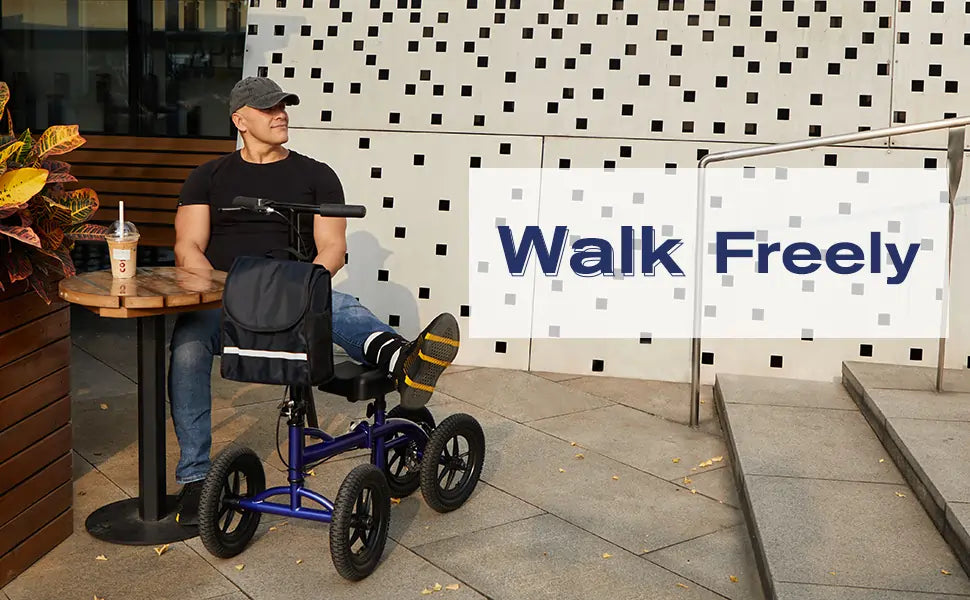
How to Use a Knee Scooter?
Knee scooters are an excellent alternative to crutches and provide flexibility and independence for those recovering from foot surgery, fractures, or other lower extremity injuries.
But, do you know how to use a knee scooter without getting more panicked than walking?
Let’s dive into the world of knee scooters and make you a pro in no time.
Part 1. Choosing the Right Knee Scooter
Before you start using your knee scooter, it’s crucial to choose the right one. Not all knee scooters are created equal, and choosing the wrong type can be like wearing shoes that don’t fit right.
Types of Knee Scooters
- Standard Knee Scooters: Typically has rubber wheels and is suitable for smooth indoor surfaces. is the most basic choice.
- All-Terrain Knee Scooters: It is the off-road vehicle of the knee scooter world. They have larger, rugged pneumatic tires for all-terrain use.
- Pediatric Knee Scooters: Specially designed for the young ones, they are smaller in size and often more colorful, making them popular with kids.
Part 2. Assembling Your Knee Scooter
Most knee scooters arrive unassembled and you need to assemble them first. Don't worry, the assembly steps are usually simple and can be completed in less than five minutes.
Part 3.Using Your Knee Scooter (Basic)
Step 1: Safety Check
Before using the knee scooter, perform a quick safety check. Ensure that the wheels are secure and roll smoothly. Test the brakes to make sure they are functioning properly and can effectively stop the scooter.
Step 2: Adjust the Handlebar Height
Adjust the height of the handlebars to a comfortable position. The handlebars should be at a level where your arms are slightly bent while holding them, allowing you to maintain an upright posture without stooping.
Step 3: Position Your Hands
Place your hands on the handlebars, ensuring a firm yet comfortable grip. This helps in maintaining control while maneuvering the scooter.
Step 4: Place Your Injured Leg
Carefully position your injured leg on the knee pad, keeping your knee centered. It’s crucial for maintaining balance that your knee stays in the middle of the pad throughout the scooter’s use.
Step 5: Start Moving and Steering
Release the brake and use your good leg to take small, controlled steps forward or backward. As you move, gently turn the handlebars to steer. Remember to keep movements smooth and gradual for better balance and control.
Part 4. Advanced Tips for Using Your Knee Scooter
1. Navigating Different Terrains
- Smooth Surfaces: Ideal for easy maneuvering. Maintain a steady pace.
- Carpet and Soft Surfaces: Require more effort. Push harder for movement.
- Outdoor Terrains (Grass, Gravel): Move cautiously, be prepared for uneven surfaces.
- Inclines and Declines: Lean slightly forward when going uphill and use brakes to control speed downhill.
2. Mastering Turns
-
Wide Turns: For safety, always take wide, gradual turns.
-
Slow Down: Reduce your speed before turning to maintain balance.
3. Reversing
- Cautious Movement: Gently push back with your good foot. Avoid quick or sudden movements to prevent tipping.
- Spatial Awareness: Be aware of your surroundings to ensure there’s enough space to reverse safely.
Part 5.About Using Safety
Safety and maintenance are crucial for effective knee scooter use.
Regularly check brakes and wheels for functionality, ensure the knee pad is stable and comfortable, and always wear shoes with good traction.
Key safety tips include avoiding wet or slippery surfaces, being mindful of obstacles, and storing your scooter properly to avoid damage.
Remember, when in doubt, consult a professional for maintenance and your healthcare provider for advice on safe usage.
Conclusion
Congratulations! You're now well-equipped with the know-how to use a knee scooter confidently. Remember, practice makes perfect. Don’t be discouraged if it feels a bit tricky at first; you’ll be zipping around with ease before you know it. Always prioritize safety, and don’t hesitate to reach out to a healthcare professional if you have concerns about your mobility needs. Happy scooting!
FAQs
1. Q: Is a knee scooter better than crutches?
Yes, for many people, knee scooters offer greater stability, comfort, and ease of movement compared to crutches, especially for longer periods of use.
2. Can I use a knee scooter if I have had knee surgery?
It's best to consult with your doctor. Knee scooters are generally used for foot or ankle injuries, and may not be suitable for those recovering from knee surgery.
3. How long does it take to get used to a knee scooter?
This varies per individual, but most people get comfortable within a few days of regular use. Practice in a safe, open area to build your confidence.
4. Can knee scooters be used on stairs?
No, knee scooters are not designed for stair use. You should always use an elevator or a ramp, or switch to crutches or a walker for navigating stairs.
5. Are knee scooters adjustable for different heights?
Yes, most knee scooters have adjustable handlebars and knee pads to accommodate users of different heights for comfortable use.

